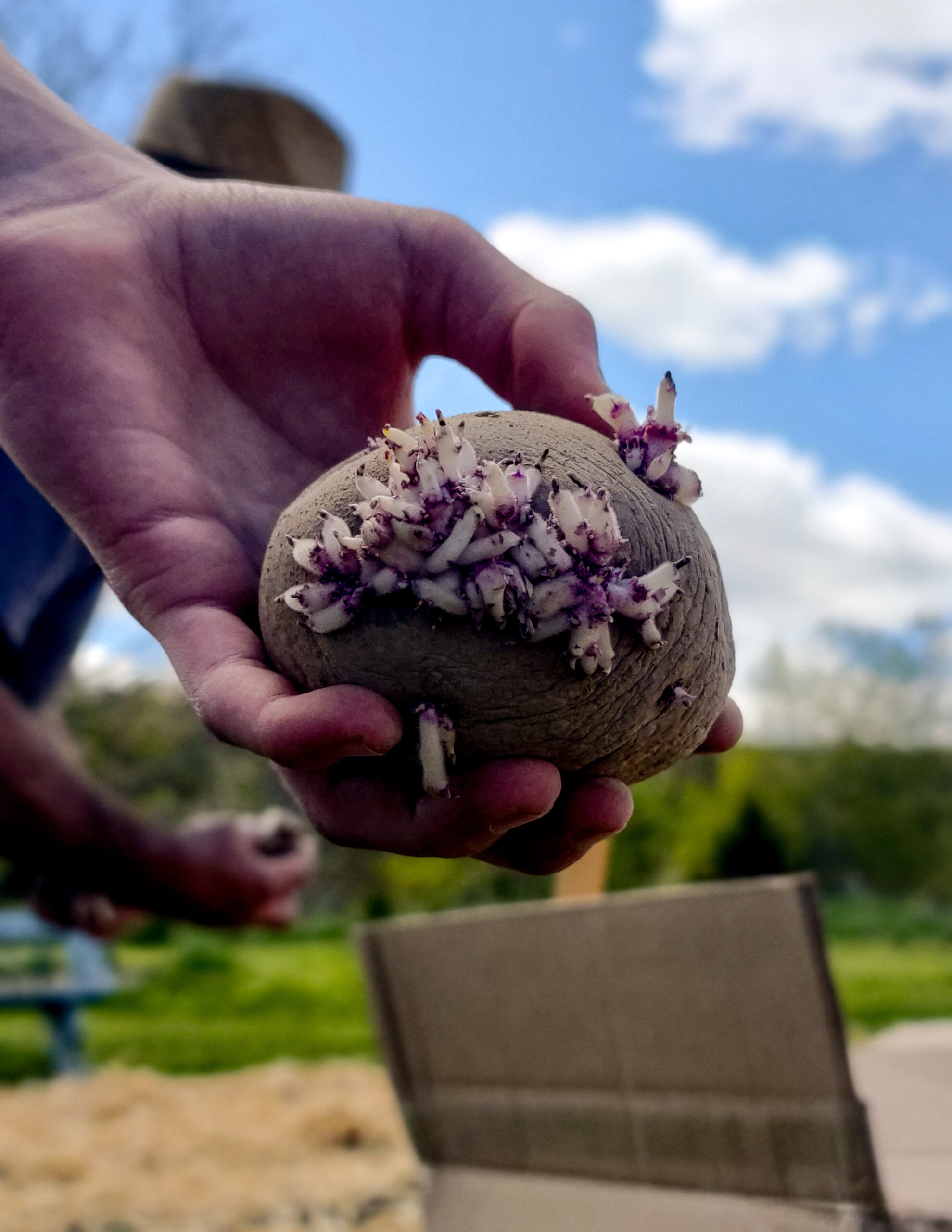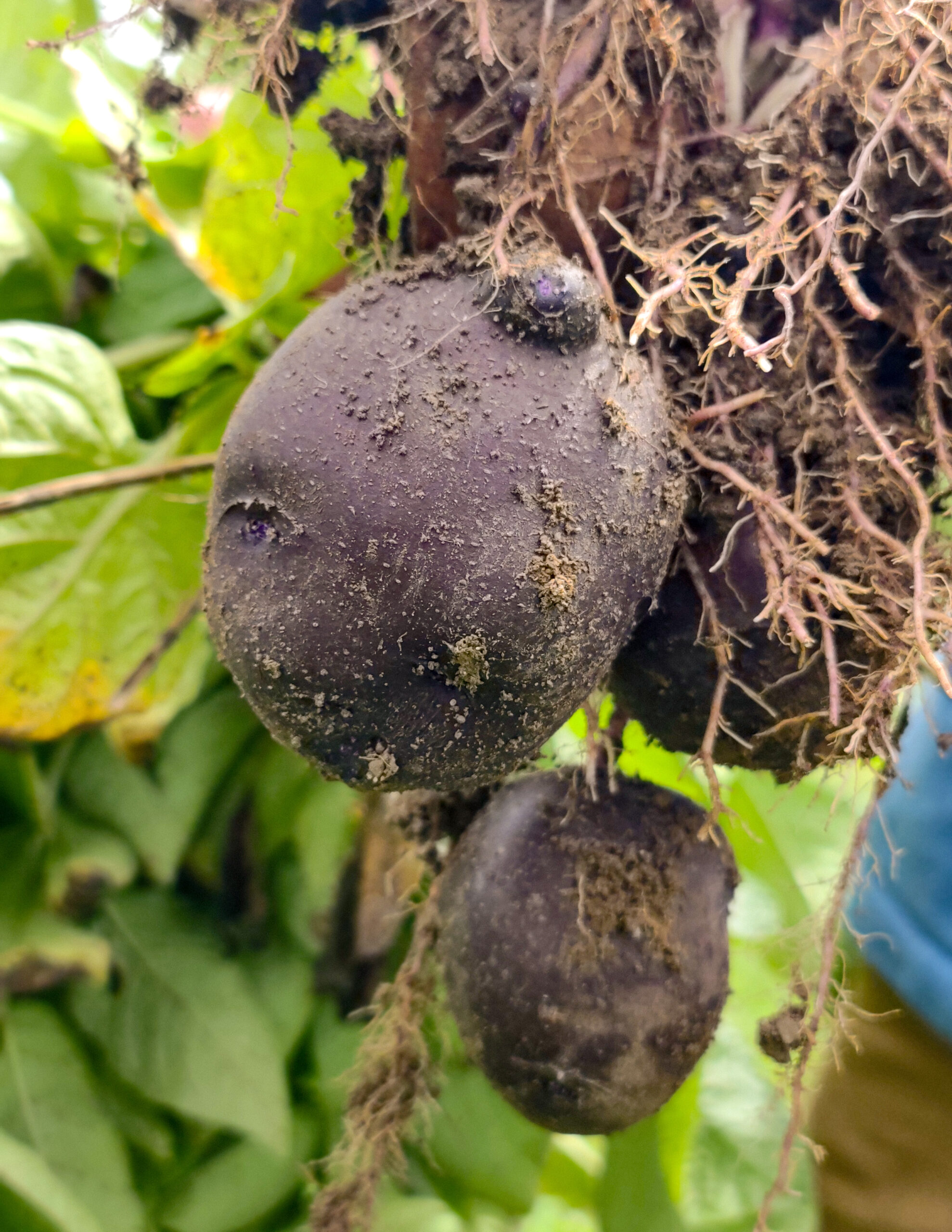Learn how to harvest and store potatoes on the homestead. Discover when to plant, how much to feed a family for a year, yields per plant, and the best potato varieties for cooking, mashing, and frying. Embrace sustainable living with our expert guide.
Mid-July signals the time on the homestead to harvest the potatoes we planted in April. We rely on our potato crop until the next harvest season, growing roughly 20 pounds of seed potatoes this year. Our favorite varieties, like Norkotah, Purple Viking, and Satina, provide a versatile ingredient for many back-to-basics recipes, including French fries, potato chips, hash browns, homemade tater tots, and so much more.
We've been planting potatoes here since 2011, with up to a quarter of an acre planted at times. For many years, we sold organic potatoes to the public. Our second eldest son, now 16, has been our "potato guy" since he was 3. He takes pride in planting, hilling, and harvesting our potato crops, ensuring a bountiful and healthy harvest each season.
Today, I'll cover everything you need to know about planting, harvesting, and storing potatoes. I'll also discuss how much to plant to feed a family for a year, the yield of a single potato plant, and the best varieties for different cooking methods.


When to Plant Potatoes:
In zone 6a, the best time to plant potatoes is in early to mid-April, once the soil has warmed up and can be worked. Potatoes prefer cool weather for their initial growth, so planting them in early spring ensures they develop correctly before the summer heat.
Steps to Plant Potatoes:
1. Prepare the Soil: Potatoes thrive in loose, well-drained soil. To enrich the soil, add compost or well-rotted manure.
2. Cut Seed Potatoes: Cut the seed potatoes into pieces, each with at least one "eye" or bud. Allow the cut pieces to dry for a day or two to prevent rot.
3. Plant the Pieces: Plant the seed potato pieces about 4 inches deep and 12 inches apart in 2-3 feet apart rows. Cover with soil and water well.
4. Hill the Plants: As the potato plants grow, mound soil around the base to cover the lower stems and provide support. This hilling process encourages tuber development and prevents greening.
How Much to Plant to Feed a Family for a Year:
Determining how much to plant depends on your family’s potato consumption. For our large family, we plant roughly 20 pounds of seed potatoes to ensure we have enough to last until the next harvest season. Here’s a general guideline to help you decide how much to plant:
1. Estimate Usage: Consider how often your family eats potatoes. An average family might consume 5-10 pounds of potatoes per week.
2. Calculate Quantity: If your family consumes 10 pounds per week, you’ll need about 520 pounds of potatoes yearly. Since each pound of seed potatoes can yield 10 pounds of harvested potatoes, planting 50-60 pounds should be sufficient.
3. Add a Buffer: Plant extra to account for losses due to disease, pests, or poor growing conditions. Planting 60-70 pounds should provide a sufficient buffer.

How Much Does One Potato Plant Yield?
On average, one potato plant can yield about 2-5 pounds of potatoes, depending on the variety and growing conditions. You can expect a good harvest from each plant with proper care and favorable weather. Factors influencing yield include soil quality, water availability, and pest management.

How to Harvest and Store Potatoes:
Harvesting potatoes at the right time and storing them properly is crucial for ensuring a long-lasting supply. Here’s how to do it:
When to Harvest:
Early Varieties: These are ready to harvest about 70-90 days after planting when the plants begin to flower.
Main Crop Varieties: These are ready about 100-120 days after planting when the foliage starts to yellow and die back.

Steps to Harvest Potatoes:
1. Wait for the Right Time: Harvest when the foliage has died and the potato skins have thickened. For early varieties, harvest when the plants flower if you want new potatoes.
2. Loosen the Soil: Gently use a garden fork or spade to loosen the soil around the plants, being careful not to damage the potatoes.
3. Lift the Potatoes: Carefully lift the potatoes from the soil. Brush off excess dirt, but do not wash them, as moisture can cause rot.
4. Cure the Potatoes: Lay the potatoes in a single layer in a cool, dark, and well-ventilated area for about two weeks. This curing process toughens the skins, helping them to last longer in storage.

How to Store Potatoes:
1. Choose a Cool, Dark Place: Store potatoes in a cool (40-50°F), dark, and well-ventilated area, such as a basement, root cellar, or garage.
2. Avoid Moisture: Keep the storage area dry to prevent rot. Please do not wash the potatoes before storing them.
3. Check Regularly: Inspect stored potatoes regularly and remove any that show signs of spoilage to prevent them from spreading.
What Potatoes Are Best for Cooking, Mashing, Frying, and Taste Profile:
Different potato varieties have different textures and flavors, making some better suited for specific cooking methods. Here are some of our favorite varieties and their best uses:
Norkotah:
Best for: Baking, Mashing, Frying
Taste Profile: Norkotah potatoes have a mild, earthy flavor that complements various dishes. When baked or mashed, their high starch content contributes to a light, fluffy texture. This makes them an excellent choice for recipes with a creamy and smooth consistency.
Gold Rush:
Best for: Baking, mashing, roasting.
Taste Profile: Gold Rush potatoes have a creamy texture and a mild, buttery flavor. They hold their shape well when baked or roasted and make excellent mashed potatoes.
Purple Viking:
Best for boiling, frying, and baking.
Taste Profile: Purple Viking potatoes have a moist, creamy texture with a slightly sweet and nutty flavor. Their vibrant purple skin and white flesh make them a beautiful addition to any dish.
Satina:
Best for boiling, mashing, and salads.
Taste Profile: Satina potatoes have a smooth, waxy texture and a rich, buttery flavor. They hold their shape well and are ideal for boiling and using in potato salads.
Harvesting and storing potatoes is a rewarding experience that ensures a year-round supply of this versatile staple. By planting at the right time, estimating the right amount to plant, understanding the yield of each plant, and following proper harvesting and storage techniques, you can enjoy homegrown potatoes in all your favorite recipes.
From Gold Rush and Purple Viking to Satina, choosing the right potato variety for each cooking method enhances the flavor and texture of your dishes. Whether you’re making French fries, mashed potatoes, or potato salads, homegrown potatoes provide unparalleled taste and satisfaction.
Stay tuned to our blog for more tips and insights on homesteading and back-to-basics living. Happy gardening, and enjoy your potato harvest!






Leave a Reply